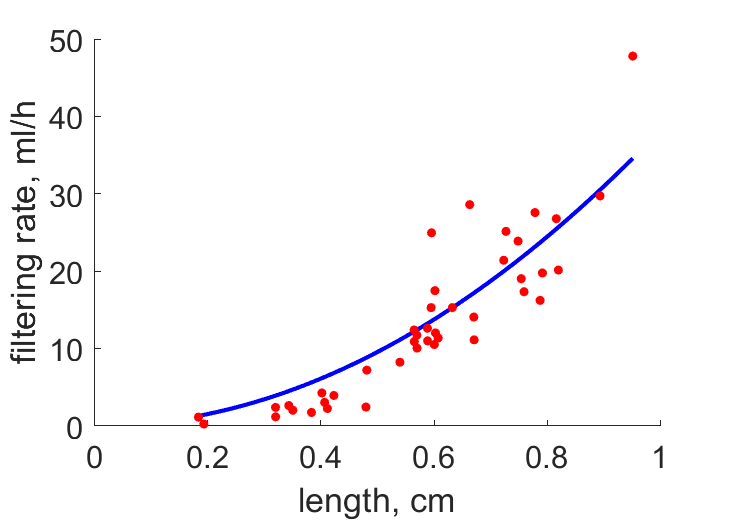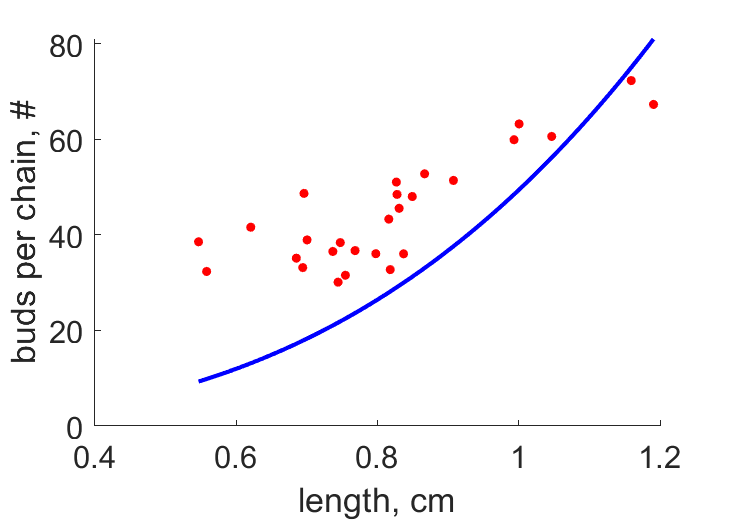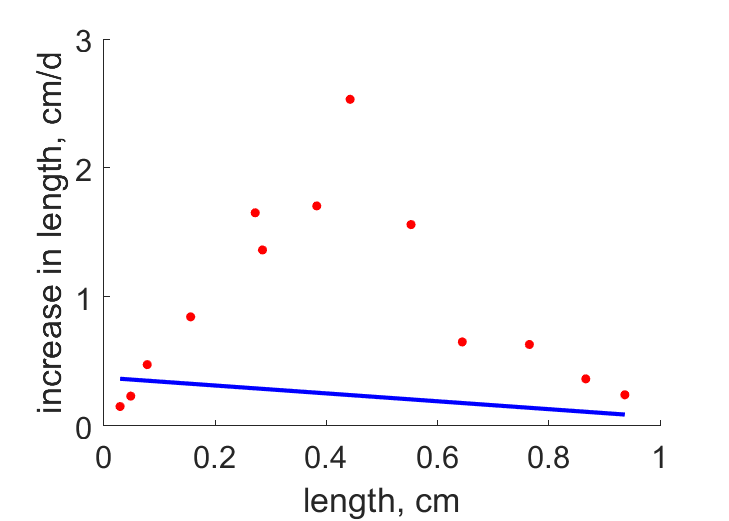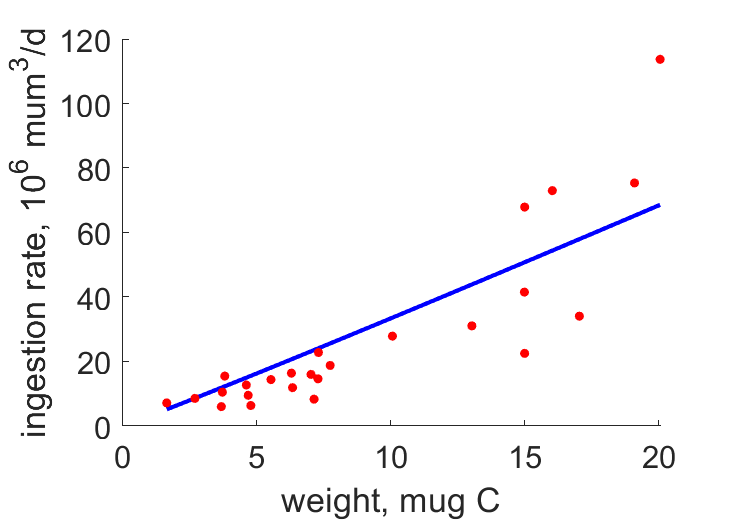Predictions & Data for this entry
| Model: stf | climate: MA, MB, MC | migrate: | phylum: |
| COMPLETE = 3.0 | ecozone: MC | food: biP | class: |
| MRE = 0.282 | habitat: 0iMp | gender: Hsff | order: |
| SMSE = 0.250 | embryo: Mp | reprod: Aa | family: |
Zero-variate data
| Data | Observed | Predicted | (RE) | Unit | Description | Reference |
|---|---|---|---|---|---|---|
| ab | 0.75 | 1.02 | (0.3599) | d | age at birth | Hens2009, BorgMoll1986 |
| ap | 1 | 1.218 | (0.2178) | d | age at puberty | BorgMoll1986 |
| am | 2.75 | 2.75 | (5.193e-05) | d | life span | Hens2009, BorgMoll1986 |
| Lb_asex | 0.3 | 0.3121 | (0.04031) | cm | length at birth, asex generation | Hero1972 |
| Lb_sex | 0.175 | 0.1301 | (0.2565) | cm | length at birth, sex generation | Hero1972 |
| Lp_asex | 0.54 | 0.3495 | (0.3527) | cm | length at puberty, asex generation | Hero1972 |
| Li_asex | 1.24 | 1.222 | (0.01452) | cm | ultimate length, asex generation | Hero1972 |
| Wwb_asex | 0.003726 | 0.0009832 | (0.7361) | g | wet weight at birth, asex generation | Hero1972 |
| Wwp_asex | 0.01159 | 0.001381 | (0.8808) | g | wet weight at puberty, asex generation | Hero1972 |
| Wwi_asex | 0.05764 | 0.05902 | (0.02396) | g | ultimate wet weight, asex generation | Hero1972 |
| Ri_asex | 336 | 365 | (0.08632) | #/d | maximum reprod rate, asex generation | BorgMoll1986 |
Uni- and bivariate data
| Data | Figure | Independent variable | Dependent variable | (RE) | Reference |
|---|---|---|---|---|---|
| LF |  | length | filtering rate | (0.2531) | Mull1983 |
| LN |  | length | buds per chain | (0.345) | Hens2009 |
| LdL |  | length | increase in length | (10.38) | Hero1972 |
| WJX |  | weight | ingestion rate | (0.3758) | Deib1982 |
Pseudo-data at Tref = 20°C
| Data | Generalised animal | Thalia democratica | Unit | Description |
|---|---|---|---|---|
| v | 0.02 | 0.06648 | cm/d | energy conductance |
| p_M | 18 | 8000 | J/d.cm^3 | vol-spec som maint |
| k_J | 0.002 | 0.002 | 1/d | maturity maint rate coefficient |
| k | 0.3 | 0.000522 | - | maintenance ratio |
| kap | 0.8 | 0.1 | - | allocation fraction to soma |
| kap_G | 0.8 | 0.8016 | - | growth efficiency |
| kap_R | 0.95 | 0.95 | - | reproduction efficiency |
Discussion
- This file is on the asexual (oozooid) stage, treating budding as foetal developemnt.Notice that size at birth of asexual stage is larger than that of sexual stage which affects reprodcutive output in #/time
- Parameter estimates tuned by hand
Facts
- Length measurements: from oral opening to posterior ridge of gut; Carbon Weight (mug C) = 1.62 Length (mm)^1.93;increase in density with length probably linked to reproductive output (Bas-interpretation); dry weight was 8.04% of wet weight; ash-free dry weight was 46.5 % of dry weight; carbon weight was 38.7 % of ash-free dry weight; wet-weight = 69 * C-weight; this result is inconsistent with observations; Ww_i = 69e-6 * 1.62 * 10^1.93 = 0.0095 g, but HeroMcWi1988 measured 0.039667 g; We_b = 60e-6 * 1.62 * 0.53^1.93 = 0.00003283 g, but HeroMcWi1988 measured 0.00011146 g; Wet weight excludes water in internal cavity; Carbon was found to be a better reference measurement than either wet or dry weight; C: N ratio was 3.81 : 1; Salp weight increases as length squared rather than cubed, because tissue density declines with growth between 3 and 10 mm; Salp tissue density is much closer to that of other marine invertebrates, such as molluscs and crustaceans, than was previously reported; Contrary to expectations, the ratio of dry and ash-free dry weight to wet weight is high during the most rapid growth period, from 2 to 7 mm; While the average density of T. democratica in relation to wet weight is now seen to be comparable to that of molluscs and chaetognaths; (not, as previously thought, to that of medusae and siphonophores), the density of 4 mm individuals reaches that of the arthropods; (Ref: HeroMcWi1988)
- sexual generation has placental development, one asexual embryo per parent; sexual stage lives in chains, asexual one solitary; strict alternation; asexual parent buds off 20 - 80 sexual embryos at 10 mm born on a chain, fed via blood; the sexual neonates need 30 min to leave the chain; sexual embryos are 1.5 till 2 mm at budding, asexual embryos are 3 mm at birth; length measurements: max length of internal structure, excluding transparent test; (Ref: Hero1972)
- Sexual: 5h release from chain; 18h female, 2h male (20-22 C). Asexual: 24h juvenile; 24 h adult, chain forming each 5 h (20-22 C). the sexual individuals (blastozooids) are sequential hermaphrodites; first maturing as females, fertilised by older chains; after relase of the first baby, male gonads develop. (Ref: Hens2009)
Bibliography